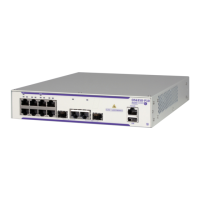QoS Policy Commands
page 39-144 OmniSwitch CLI Reference Guide November 2009
Usage Guidelines
• Use this command to determine if the switch will classify the traffic condition specified and match it to
a policy. By default the classifier only tests pending policies (policies that have not yet been applied).
Use the applied keyword to test only those policies that have been applied.
• If you specify multicast traffic, any destination parameters specified indicate the client(s) attempting to
join a multicast group.
• Use the qos apply command to activate saved policies.
• See command descriptions in the next sections for more information about the individual options.
Examples
-> show policy classify l3 source ip 1.2.3.4 destination ip 198.60.22.2
destination ip port 80 ip protocol 6
Packet headers:
L3:
*Port : 0/0 -> 0/0
*MAC : 000000:000000 -> 000000:000000
*VLAN : 0 -> 0
*802.1p : 0
L3/L4:
*IP : 1.2.3.4 -> 198.60.22.2
TCP : 0 -> 80
*TOS/DSCP : 0/0
Using pending l3 policies
Classify L3:
*Matches rule ‘filter1’: action pri3 (accept)
• Source and destination are indicated to the left and right of the arrow (->) respectively. A zero displays
for values not requested in the hypothetical packet.
• Note that some fields only display for particular traffic types.
Release History
Release 6.6.1; command was introduced.
output definitions
L2/L3/L4 Indicates the type of traffic (Layer 2 or Layer 3/4).
Port The physical slot/port of the theoretical traffic.
IfType Displays for hypothetical Layer 2 packets only. The interface type of
the packet.
MAC The MAC address of the hypothetical packet.
VLAN The VLAN ID of the hypothetical packet.
802.1p The 802.1p value of the hypothetical packet.
Mcast
Displays for hypothetical multicast packets only. The multicast address
of the hypothetical packet.
IP The IP address of the hypothetical packet.
TCP The TCP/UDP port of the hypothetical packet.
TOS/DSCP The ToS or DSCP value of the hypothetical packet.

